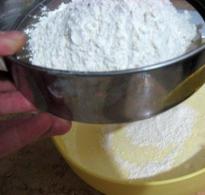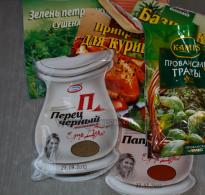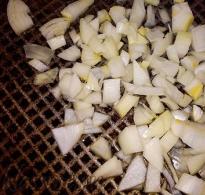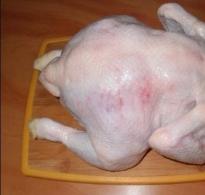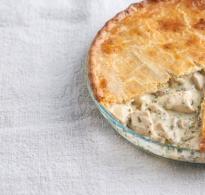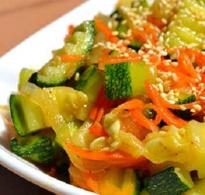Buckwheat porridge with army-style stew. Military dishes
Hello, dear site visitors. Congratulations to everyone on Victory Day! Peaceful skies above everyone's heads and a calm, bright life. And I would like to wish my compatriots from Ukraine that the next victory day will be more joyful and festive.
I don’t know how it is for anyone, but for me Victory Day is always associated not only with parades, congratulations to veterans and concerts, but also always with the soldier’s porridge, which was prepared for the holiday on field kitchens. As a child, it seemed that nothing could be tastier than this porridge, and that it would never turn out like this at home. I wondered what real soldier’s porridge should be like and how to prepare it correctly?
After conducting information reconnaissance, I found out that there are actually no essential rules for preparing soldier’s porridge. This is basically quite normal. After all, this porridge was originally prepared during the period of hostilities, and then there was no time for special pickles, there would have been something to eat. The main thing in the recipe is that cereals and meat are available, because the soldiers had to be fed nourishingly and tasty.
A little history

The history of military marching porridge goes back to the distant past. The idea of this dish is attributed to the great commander Alexander Vasilyevich Suvorov. There is a legend that it was he who, on one of the days of crossing the Alps, when food supplies were running low, offered to cook porridge for the soldiers from everything that was available. Then not only the remains of lard and meat were used, but also peas, pearl barley, millet and buckwheat. The soldiers were fed, and this is the main guarantee of success in battle and victory.
I think that in Suvorov’s times, the meat for soldiers’ porridge was either fried or pre-cooked, and the cereal was already poured into the broth. During the Great Patriotic War and to this day, stewed meat is most often used as a meat dressing. This is due to the fact that with its help it is faster and easier to cook porridge in military field conditions. Now soldier's porridge They are cooked mainly from millet, pearl barley or buckwheat.

1. Real soldier's porridge made from army pearl barley. Since pearl barley is quite hard, it takes a long time to cook. To reduce cooking time, you can soak it overnight, pour cold water. In the morning, the cereal needs to be washed several times. Then fill it with water, keeping in mind that you will need five to six times more liquid than pearl barley. Cook the porridge for at least an hour until all the water has almost boiled away. At this time, fry finely chopped onion and grated carrots in vegetable oil or butter until golden brown. Vegetable mass pour into boiling porridge, add stewed meat. Taste it, add salt and spices. Let the porridge boil for a few minutes, turn off the heat and let it brew for half an hour or an hour. It’s good to wrap the pan in a towel or pillows during this time. Then we proceed to the army meal.
2. Soldier's buckwheat porridge. want to fully experience the taste of camp food? Then get this ready army dish at the dacha, picnic or at a tourist stop. The speed of preparation will allow you to spend a minimum of time. So, to get eight to ten servings you will need two glasses of buckwheat and two small cans of stew. After pouring the cereal into a boiling pot of water, pay attention to the liquid level. To ensure that the porridge is well-cooked and at the same time crumbly, ensure moderate heat. The water should cover the top of the porridge by two to three centimeters. After 15-20 minutes of cooking, you can add stewed meat, salt and herbs. Stir and let simmer for one or two minutes. Soldier's buckwheat porridge is ready!
As you can see, nothing complicated. Simple Products, simple conditions, simple kitchen, but tasty, satisfying and native. Prepare soldier's porridge with your loved ones and perhaps its preparation will become a good tradition for your family on May 9th.
You might also be interested in:

Cooking recipes from the war years are very simple. Their main ingredients are boiling water, cereals, potatoes, and, if you're very lucky, stewed meat. We have collected some front-line and rear-facing recipes especially for the younger generation. Their main value is that they were recorded directly from the words of veterans - living witnesses of that era.
The further the 40s of the last century move away from us, the more difficult it is to imagine to us, and especially to new generations, the whole tragedy that our country experienced in those years. Of course, there are still photographs and newsreels, as well as feature films. But, alas, they are not able to convey either the smell or the taste of those years, and yet it is precisely these sensations that sometimes speak better than a thousand words.
FRONT KULESH (recipe from 1943)
Brisket on the bones - 0.5 kg. (or stew)
Millet – 250-300 gr.
Potatoes – 3-4 pcs.
Onions – 2-3 bulbs
Take half a kilo of bone-in brisket (can be replaced with stew). Cut off the meat and cook the bones for 15 minutes in boiling water (1.5 - 2 liters). Add 250–300 grams of millet and cook until tender. 3-4 peeled potatoes, cut into large cubes and send there.
Fry the meat cut from the bones with onions (2-3 onions) in a frying pan and add to the pan. Cook the dish until done, about 10 minutes.
It turns out delicious and hearty dish(either gruel, or thick soup).
PASTA “BALTIC”
Pasta (500g),
Meat (preferably on ribs, 500g),
Onions (150-200g)
The meat is cooked until cooked, cut into cubes. The pasta is boiled until tender. The onion is sautéed in a frying pan until golden brown.
Mix the meat, pasta and onion in a cauldron or saucepan, add a little meat broth and send for 10-20 minutes to hot oven(temperature 210-220 degrees).
LENT SOLYANKA “REAR”
This dish was often prepared during the hard times of the war and in the hungry post-war years by my grandmother, now deceased. We often used grandma’s recipe in good times and ate this “hodgepodge” with pleasure - even if not in a cast iron pot, but in regular saucepan she was stewing.”
Sauerkraut
Potato
Bulb onions
Bay leaf
Salt pepper
Place equal amounts of sauerkraut and peeled, sliced potatoes into a cast iron pot. Pour in enough water to cover the cabbage-potato mixture. After this, put the cast iron on the fire and simmer.
And 5 minutes before it’s ready, you need to add chopped onion fried in vegetable oil, a couple of bay leaves, pepper, and salt if necessary to taste.
When everything is ready, you need to cover the vessel with a towel and let it simmer for half an hour.
PEA SOUP
Pearl barley (optional)
Potato
Onion carrots
Stew
Soak the peas overnight in cold water. You can add pearl barley to it.
The next day, boil, shortly before readiness, add the potatoes and pre-fried in lard, onions and carrots (they were added just like that, without frying). Lastly, add the stew.
SOLDIER'S cabbage soup
Meat (or stew)
Sauerkraut
Potato
Carrot
Tomato puree
Boil the meat, shortly before it’s ready, add the washed meat to the broth. sauerkraut and potatoes cut into large cubes. Just before it's ready, add carrots, onions and tomato puree, fried in lard. Cook until done.
At the very end, add toasted flour diluted in broth or water, add salt and bay pepper. If meat is unavailable, replace it with stewed meat.
PORridge WITH GARLIC
Millet (1 cup),
Water (3 glasses),
Sunflower oil,
Garlic, onion and salt.
Fry the onion in vegetable oil. Fill the cereal with cold water and put it on fire. As soon as the water boils, add our frying mixture, salt the porridge and cook for another 5 minutes. Peel and finely chop the head of garlic. Remove the porridge from the heat, add garlic to it and, closing the lid, wrap it in a “fur coat” and let it steam. The porridge turns out aromatic, soft and tender.
BUCKWHEAT
Stew (1 can, 300-400g),
Buckwheat (300 g),
3-4 glasses of water,
3-4 onions,
Salt, Bay leaf
Fry the onion in lard. Mix the stew, buckwheat and fried onions in a saucepan. Pour in water, add salt and cook, stirring, until tender.
BREAD “RZHEVSKY”
Potato
Boil the potatoes in their jackets, peel them, and pass through a meat grinder. Place the resulting mass on a baking sheet sprinkled with bran and cool. Add bran, salt, quickly knead the dough and, placing in a greased pan, bake until done.
PIE WITH BUCKWHEAT
But the recipe is very delicious pie, which during the war was very often prepared by residents of the rural areas of the Urals, and which my beloved grandmother still cooks to this day. Wherever I have been, I have never seen such a recipe anywhere except in my homeland.
Yeast dough
Buckwheat
Prepare the usual yeast dough, boil until almost done buckwheat porridge(evaporate the water). Fry the mushrooms with onions or simmer until tender, then cool and mix with porridge. Make a pie with a thin top crust and bake in the oven until done.
The result will be very tasty if the pre-cooked buckwheat porridge is crumbly.
You can add minced meat or stewed meat fried in a frying pan to the filling.
Step-by-step recipes for quick and tasty buckwheat porridge with stew
2017-10-04 Natalia DanchishakGrade
recipe
Time
(min)
Portions
(persons)
In 100 grams ready-made dish
10 gr.
17 gr.
Carbohydrates
21 gr.274 kcal.
Option 1. Buckwheat porridge with stewed meat: classic version
Buckwheat porridge with stewed meat - hearty and tasty dish for the whole family. The easiest way to cook it is to boil buckwheat and mix with stew. But it will be even tastier and healthier if you add vegetables.
Ingredients
- 200 g buckwheat;
- salt;
- can of pork stew;
- ground pepper;
- carrot;
- a clove of garlic;
- bulb.
Open the can of stew. Skim off the top fat and place in a cauldron. Place the meat in a deep plate and mash it with a fork.
Place the cauldron on the fire. Peel and wash the vegetables. Chop the carrots into thin cubes, finely chop the garlic, and chop the onion into half rings.
Place the vegetables in the melted fat and fry, stirring constantly, until lightly browned. Add meat to roasted vegetables. Stir.
Sort out the buckwheat, rinse and place in a cauldron. Upload content drinking water in a ratio of 1:2. Stir, cover and cook until the cereal is ready.
In addition to carrots and onions, you can add other vegetables to the dish: tomatoes, bell pepper etc. The stew can be any kind: beef, pork or poultry, the main thing is that it is of high quality.
Option 2. Buckwheat porridge with stewed meat: a quick recipe in a slow cooker
The taste of buckwheat porridge cooked in a slow cooker is no different from what our grandmothers cooked in Russian ovens. The big advantage is that you just need to add food, close the lid, and then the device will do everything itself.
Ingredients
- can of pork stew;
- two bay leaves;
- buckwheat- two multi-glasses;
- salt;
- carrot;
- sunflower oil - 30 ml;
- onion head
Step-by-step cooking recipe
Peel the carrots and onions and wash them well. Chop the onion into thin half rings and cut the carrots into short strips.
Turn on the baking program. Pour into container vegetable oil and heat it well. Place the onion in it and fry, stirring, until transparent. Then add the onion and continue to fry for 15 minutes.
Open the can of stew, mash it with a fork and transfer it to the container of the device. Rinse the buckwheat and add to the rest of the ingredients. Season with spices, salt, pour in drinking water and stir. Close the lid and run the “pilaf” or “buckwheat” mode for 20 minutes.
The fat from the stew is added to vegetable oil and the vegetables are fried in this mixture. For cooking it is better to use stew homemade. Meat from a can must be fried before adding it to the porridge.
Option 3. Buckwheat porridge with stewed meat and mushrooms
Mushrooms go well with meat. The porridge turns out to be satisfying and incredibly flavorful. Tomato paste will add a pleasant sourness to the dish.
Ingredients
- beef stew - can;
- salt;
- buckwheat - cup;
- spices;
- fresh champignons - 100 g;
- fresh herbs;
- onion head;
- olive oil- 60 ml;
- tomato paste - 30 g.
Step-by-step cooking recipe
Remove the peel from the onion head, rinse and finely chop. Wipe the mushrooms with a damp sponge and cut into thin slices.
IN cast iron frying pan heat the olive oil. Place onions and mushrooms in it. Fry for a couple of minutes, stirring continuously.
Add to the pan tomato paste, stir. Place the stew from the jar into the frying pan, mash with a fork and stir. Simmer everything together for a few minutes.
Sort the grains, rinse and place in a frying pan. Pour two glasses of boiling water over everything. Cover with a lid, reduce heat to low and cook until the cereal has absorbed all the liquid.
Remove the pan from the heat, add salt to taste, cover again and leave for ten minutes. When serving, sprinkle with chopped dill.
Do not rinse champignons in water; they quickly absorb moisture, which they intensely release during frying. Before cooking, be sure to sort the buckwheat to remove all debris. If used Forest mushrooms or oyster mushrooms, they are pre-boiled.
Option 4: Buckwheat porridge with stew in pots
Buckwheat porridge in the oven turns out crumbly, and the meat is soft and tender. It can be served directly in pots, which keep the dish warm for a long time. You can add any spices and herbs for flavor.
Ingredients
- pork or beef stew - 300 g;
- bouillon;
- buckwheat - 270 g;
- Bay leaf;
- onion - two heads.
Step-by-step cooking recipe
Wash and rinse the pots hot water. Place a little fat and 100 g of stew on the bottom of each.
Peel the onion, wash it and chop it into small cups. Divide into three parts and place on top of the meat.
Sort the buckwheat thoroughly and rinse. Place on a sieve. Place three tablespoons of cereal in each pot.
Break the bay leaf into three parts. Add one piece to each pot.
Pour water or broth into the pots and cover with lids. Place in the oven for 45 minutes. Turn it 180 degrees.
Option 5. Buckwheat porridge with merchant-style stew
In Rus', only rich people could afford meat, so porridge with meat was called merchant's porridge. Thanks to vegetables, the porridge is also very healthy.
Ingredients
- buckwheat - one and a half glasses;
- salt;
- chicken, beef or pork stew- jar;
- freshly ground pepper;
- carrot;
- tomato;
- bulb;
- sweet pepper - pod.
Step-by-step cooking recipe
We clean and wash the vegetables. Grind everything except the tomatoes into thin strips. Cut fresh tomato into cubes.
We take a wide saucepan, place it on the stove and put the fat from the stew into it. If it is not enough, add vegetable oil. Warm up well.
Place the onion in a saucepan and fry, stirring regularly, for several minutes. Add carrots and continue cooking until soft.
Place the stewed meats in a saucepan and mash with a fork large pieces. Warm up for a few minutes.
Now add the pepper fresh tomatoes and finely chopped garlic. Stir, cover and simmer for seven minutes.
We carefully sort out the buckwheat, removing all debris. Place on a sieve and rinse under the tap. Transfer the cereal to a saucepan with vegetables. Pour in two parts of boiling water and add salt.
Cover the saucepan with a lid, reduce the heat to low and simmer until the cereal has absorbed all the liquid. Ready porridge pepper, mix and add butter. Cover with a lid, wrap in a towel and leave for ten minutes.
The porridge will turn out tastier if you fry the buckwheat in a dry frying pan before cooking. Salt the dish only after adding the stew. Cook the porridge over low heat; due to slow simmering, it will turn out crumbly. Serve with fresh or pickled vegetables.
Name today's recipe– buckwheat porridge with army-style stew, most likely, came precisely from the ease of preparation and fast process. This version of porridge is like a lifesaver when you don’t have any time to cook, but you need to feed your family. For the recipe it is best to use proven delicious stew, beef, chicken or pork will be perfect - here it’s more likely what you like best. We will also add some carrots and onions, the result will definitely not disappoint anyone. Buckwheat porridge can be served with homemade pickles or fresh vegetables, you can also add greenery. Be sure to try this one too. 
- buckwheat – 0.5 tbsp.,
- water – 1 tbsp.,
- chicken/beef/pork stew – 350 g,
- carrots – 1 pc.,
- young onion – 1 pc.,
- salt, pepper - to taste.
Recipe with photos step by step:

Prepare everything necessary ingredients, peel one medium-sized carrot, rinse and dry it. Cut the carrots into cubes, finely chop the young onion.
Melt the fat from a can of stewed meat in a frying pan, then add carrots and onions to the fat, lightly fry the vegetables. 
Now transfer the stew into the frying pan and stir. Be sure to test the stew for salt and pepper in order to further understand the taste of the finished dish. So, if necessary, add a pinch of salt and ground pepper. 
Pre-rinse the buckwheat, dry it, throw it into a dry frying pan and heat until a pleasant aroma of buckwheat appears. Transfer the prepared cereal into a quick bowl with carrots and stewed meat. 
Pour a glass straight into the pan warm water, stir and place on low heat, cover the pan with a lid. Simmer the buckwheat for 15-20 minutes, then leave it covered for another 10-15 minutes. After a while, divide the buckwheat into plates and serve. Also see how it is prepared
Today we are preparing what they feed you in field kitchens on holidays like Airborne Forces Day or Tankman Day. Well, just at public events. How to make real buckwheat with stew - listen, write down and cook!
We can say that the “buckwheat with stew” dish is generally ideal.
Well, look for yourself:
Prepares quickly and easily
Buckwheat is very tasty, easily absorbs flavors and does not become boring
A little meat is required, and not the best quality.
So, about meat separately.
If you cook this from tenderloin, nothing will work.
And if you take a soup set with sinews and other bones (you choose them, of course) - it will be delicious.
And our familiar stew in jars is made from exactly this.
Someday I will do the same thing using not a can of stew, but a kilogram of soup set and sinew, and it will turn out to be a delicious thing!
But for now the banks.
They must be chosen carefully.
1. Read the front label, obverse. If it says anything other than “stewed beef”, we don’t take it.
2. Read the reverse label. If there is anything there other than “beef, bay leaf, salt, spices,” we don’t take it.
We are looking for exactly these records. It’s expensive, probably a jar of 150 rubles. But anything else will be hellish shit!
We look at the edge - like with a coin. Let's chat. It may gurgle in a warm jar. The one standing in the refrigerator is as hard as steel!
So, the composition:
Stewed meat, 2 cans (you can have one, I love meat, I took two, but different ones. Both are correct)
Buckwheat, one and a half glasses
Water, three glasses. A solid course of buckwheat when cooked 1:2 and not otherwise!
Onion
Garlic
02
This is what it looks like open jar excellent stew. Fat - it was under the lid in a white solid layer, I dumped it into a separate bowl.
03
It's me
04
I decided to cook in a homemade cauldron. It's more convenient than a saucepan. It will not burn and the heat is evenly distributed.
The cauldron was lying with friends, and they had previously washed it from pilaf, apparently with means. Cast iron cauldron easily absorbs odors.
I poured a little vegetable oil, calcined the onion in it, and greased all the walls of the cauldron with oil. I poured it all out.
05
I took the stew out of the cans, cut it into small pieces and added a couple of cloves of garlic.
06
In a cauldron, I melted the fat taken out of the cans and fried the onions in it - just like pilaf!
07
As soon as the onions were fried, poured in two parts of the amount of buckwheat with water, added the buckwheat and set the heat to the lowest setting. Let yourself languish!
08
When the buckwheat is almost cooked (but there is still water), you need to salt it. This is the most difficult moment. The fact is that the stew itself is salty. The main thing is not to oversalt!
And as soon as the buckwheat is almost, almost completely ready, we add meat to it. Stir, keep on the fire for five minutes, stirring, and then another 20 minutes in a cauldron wrapped in towels, blankets, warm cats and the wife.
And you can serve!
Bon appetit!

